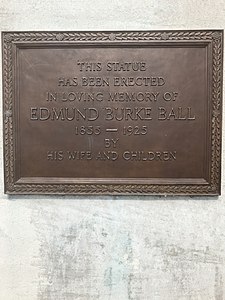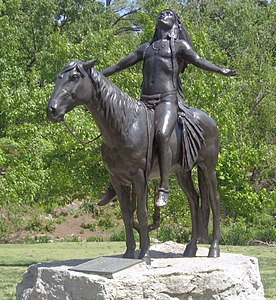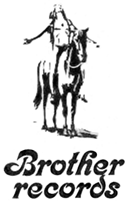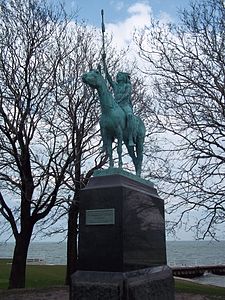Appeal to the Great Spirit
| Appeal to the Great Spirit | |
|---|---|
 | |
| Artist | Cyrus Edwin Dallin |
| Year | 1908 |
| Type | Bronze |
| Dimensions | 290 cm × 250 cm × 300 cm (114 in × 100 in × 120 in) |
| Location | Boston, United States |
| 42°20′19″N 71°05′37″W / 42.33873°N 71.09367°WCoordinates: 42°20′19″N 71°05′37″W / 42.33873°N 71.09367°W | |
| Owner | Boston Museum of Fine Arts |
Appeal to the Great Spirit is a 1908[1] equestrian statue by Cyrus Dallin, located in front of the Museum of Fine Arts, Boston. It portrays a Native American on horseback facing skyward, his arms spread wide in a spiritual request to the Great Spirit. It was the last of four prominent sculptures of Indigenous people, which also includes A Signal of Peace (1890), The Medicine Man (1899), and Protest of the Sioux (1904).
A statuette of Appeal to the Great Spirit is in the permanent collection of the White House and was exhibited in President Bill Clinton's Oval Office.
History[]
Having grown up in Utah, the young Dallin frequently interacted with Native American children, who gave him insights that he called upon while creating this and other works. For Appeal to the Great Spirit , the model was Antonio Corsi, who posed for several great painters and sculptors of the era.[2]
Appeal to the Great Spirit was cast in Paris, and won a gold medal for its exhibition in the Paris Salon. On January 23, 1912, it was installed outside the main entrance to the Boston Museum of Fine Arts (MFA).[3] The installation was originally intend to be temporary, but the statue was never removed, and eventually came to be considered as an iconic symbol of the MFA.[4]
A restoration of the original Boston version was reversed at Dallin's request,[when?] because he preferred the light green tones that had developed on the equestrian sculpture over time rather than the typical "statuary brown" patina the conservator applied without consulting him.[5]
- Prominent Equestrian Statues of Indigenous People, by Cyrus Edwin Dallin
A Signal of Peace (1890)

The Medicine Man (1899)

Protest of the Sioux (1904)
Appeal to the Great Spirit (1908)
On March 3, 2019, the MFA convened a public discussion of the artwork among five art historians and museum curators; two of the panelists were also members of Native American tribes.[6][7] In October 2019, as part of its first community celebration of Indigenous Peoples' Day, the MFA surrounded its iconic statue with placards displaying questions and comments submitted by the community, including Native Americans.[8] In 2020, the MFA website posted two brief essays written by Native Americans commenting on the sculpture and its cultural meanings.[9][4]
In 2021, two temporary art installations were placed around and near to the sculpture. Raven Reshapes Boston: A Native Corn Garden at the MFA, by Elizabeth James-Perry, (Aquinnah Wampanoag, b. 1973), consists of corn, beans, and sedges planted in a small garden completely surrounding the statue. Ekua Holmes (African American, b. 1955), planted a large patch of sunflowers close by, called Radiant Community, as part of her ongoing Roxbury Sunflower Project.[10][11]
Other versions[]
There is a full-scale replica in Muncie, Indiana, in the intersection of Walnut and Granville streets in the Wysor Heights Historic District; it is considered by many residents to be a symbol of the city.[12] The statue was erected "In Loving Memory of Edmund Burke Ball" by "His Wife and Children".
An edition of nine 40-inch (1,000 mm) bronzes of Appeal to the Great Spirit was produced around 1922. One is now the centerpiece of the Tower Room of Dartmouth College's Baker Tower, the college's main library and most iconic building.[13]
A plaster example in this one-third scale is at the Cyrus Dallin Museum in Arlington, Massachusetts, and another is in the Rockwell Museum in Corning, New York.[14] Central High School in Tulsa, Oklahoma, possesses another plaster example, which was used in 1985 as the model for a bronze version. The casting was done by American Artbronze Fine Arts Foundry under the direction of Howard R. Kirsch. The bronze is now installed in Woodward Park in Tulsa, Oklahoma, at the intersection of 21st Street and Peoria.[15]
Examples of the 21-inch (530 mm) bronze statuette are at the White House, the US Department of State, and many American museums.[16]
An 8+1⁄2-inch (220 mm) miniature edition was produced by the Gorham Manufacturing Company in 1913; in 2009, No. 263 sold for $9,375.[17]

Muncie, Indiana

Plaque at Muncie

Woodward Park, Tulsa, Oklahoma
In popular culture[]
This section does not cite any sources. (September 2021) |

- An early instance of the sculpture's place in American culture is its appearance (as photographed by Baldwin Coolidge) on the cover of "A-M-E-R-I-C-A" (1917), a World War I song by May Greene and Billy Lang and published by D. W. Cooper.
- The sculpture is used as the logo for the Beach Boys' vanity record label Brother Records. It was first seen in the lower-left corner on the band's 1967 album Smiley Smile and its attending single "Heroes and Villains", and was used more prominently on the cover of their 1973 album The Beach Boys in Concert. When Beach Boy Carl Wilson was asked in 1975 why the group used this as their logo, he said the Indian was chosen because Brian, Dennis, and Carl's grandfather believed that there was a spiritual Indian "guide" who watched over them from the "other side". The choice of the logo was Brian's. Carl called the logo "The Last Horizon".[18]
- A painting of the sculpture appears on the cover of the album The Time Is Near (1970) by the rock group Keef Hartley Band.
- A painting of the sculpture appears on the cover of the album Spirit of God (1984) by the Native American Gospel recording artist Johnny P. Curtis.
- A painting of the sculpture appears on the cover of the album Lysol (1992) by rock group The Melvins.
- In the vinyl release of Directions to See a Ghost (2008) by the American rock band The Black Angels, the poster inside features a skeleton form of this sculpture with a psychedelic background.
See also[]
References[]
- ^ https://equestrianstatue.org/appeal-to-the-great-spirit/ Equestrianstatue.org
- ^ Craven, Wayne (1968). Sculpture in America. New York: Thomas Y. Crowell Company. pp. 530–531. ISBN 9780690722406. Retrieved 2013-07-13.
- ^ "Appeal to the Great Spirit". Boston Art Commission. Retrieved 2013-07-22.. See also "Big Bronze Statue by Cyrus Dallin Placed at Museum", The Christian Science Monitor, January 24, 1912, p. 1.
- ^ a b Bermeo, Layla; Lukey (Aquinnah Wampanoag), Tess (September 2020). "Appeal to the Great Spirit". collections.mfa.org. MFA Boston. Retrieved 2021-09-20.
- ^ Technology & Conservation. Vol. 2. Technology Organization. 1983.
- ^ "Dallin experts discuss sculptor's work, 'Appeal to the Great Spirit'". The Arlington Advocate. Mar 12, 2019. Retrieved 2021-09-20.
- ^ "Cyrus Dallin's Appeal to the Great Spirit Reexamined". Museum of Fine Arts, Boston. Retrieved 2021-09-20.
- ^ "Cyrus Dallin's 'Appeal to the Great Spirit'". Museum of Fine Arts, Boston. Retrieved 2021-09-20.
- ^ Zordan, Joseph (July 6, 2020). "Appeal to the Great Spirit". Museum of Fine Arts, Boston. Retrieved 2021-09-20.
- ^ "Ekua Holmes and Elizabeth James-Perry's 'Garden for Boston' to Transform Grounds Outside MFA Boston". ArtfixDaily. May 12, 2021. Retrieved 2021-09-20.
- ^ "Garden for Boston". Museum of Fine Arts, Boston. June 22 – October 12, 2021. Retrieved 2021-09-20.
- ^ "Appeal to the Great Spirit". City of Muncie. Archived from the original on 2013-12-10. Retrieved 2013-07-22.
- ^ "Cyrus Edwin Dallin, American, 1861-1944". Hood Museum of Art. 29 April 2009. Retrieved 2013-07-22. Dartmouth was founded as an institution to educate the Native Americans of New England, and it recalls that heritage through art such as Dallin's Appeal to the Great Spirit.
- ^ "Appeal to the Great Spirit". Rockwell Museum of Western Art. Archived from the original on 2013-07-25. Retrieved 2013-07-22.
- ^ "Appeal to the Great Spirit, (sculpture)". Smithsonian Institution Research Information System(SIRIS). 1996. Retrieved 2013-07-22.
- ^ ""Appeal to the Great Spirit" by Cyrus Edwin Dallin". Joy of Museums Virtual Tours. Retrieved 2021-09-20.
- ^ "Cyrus Edwin Dallin (1861-1944): Appeal to the Great Spirit". Christie's. 5 March 2009. Retrieved 2013-07-22.
- ^ Proebe, Larry (1995). "The Beach Boys' Brother Records Logo". In Priore, Domenic (ed.). Look, Listen, Vibrate, Smile!. Last Gasp. p. 141. ISBN 0-86719-417-0.
Brian May (guitarist of Queen) refers this art on Dec 24,2020 https://www.instagram.com/tv/CJMdur2hhAT/?igshid=m99pde8den6s
External links[]
| Wikimedia Commons has media related to Appeal to the Great Spirit. |
- Wikimapia: Appeal to the Great Spirit locations
- Save Outdoor Sculpture Survey for Boston Sculpture
- Save Outdoor Sculpture Survey for Muncie Sculpture
- Save Outdoor Sculpture Survey for Oklahoma City Sculpture
- Cyrus E. Dallin Museum Arlington, Massachusetts
- Equestrian statues in Massachusetts
- Sculptures of Native Americans
- Outdoor sculptures in Boston
- Outdoor sculptures in Indiana
- 1908 sculptures
- Sculptures of the Museum of Fine Arts, Boston
- Sculptures of men in Massachusetts
- 1909 establishments in Massachusetts
- Art in the White House
- Works by Cyrus Edwin Dallin
- Fenway–Kenmore








